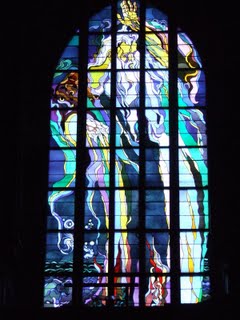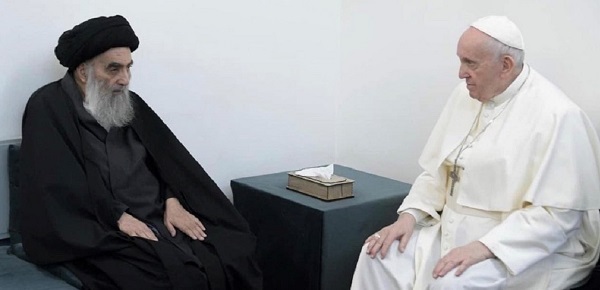| The philosophical approach known as pragmatism, as propounded by the American philosopher William James, has been used to reconcile scientific with religious knowledge. Pragmatism, simplistically, holds that the truth of a set of beliefs can be indicated by its usefulness in helping people cope with a particular context of life. Thus, the fact that scientific beliefs are useful in predicting observations in the physical world can indicate a certain truth for scientific theories; the fact that religious beliefs can be useful in helping people cope with difficult emotions or moral decisions can indicate a certain truth for those beliefs. (For a similar postmodern view, see grand narrative).
RELIGION, METAPHYSICS, AND COSMOLOGY
Religion and philosophy meet in several areas, notably in the study of metaphysics and cosmology. In particular, a distinct set of religious beliefs will often entail a specific metaphysics and cosmology. That is, a religion will generally have answers to metaphysical and cosmological questions about the nature of being, of the universe, humanity, and the divine.
Mysticism and esotericism
Mysticism, in contrast with philosophy and metaphysics, denies that logic is the most important method of gaining enlightenment. Rather, physical disciplines such as yoga, stringent fasting, whirling (in the case of the Sufi dervishes), or the use of Psychoactive drugs such as LSD, lead to higher states of consciousness that logic can never hope to grasp.
Mysticism ("to conceal") is the pursuit of communion with, or conscious awareness of ultimate reality, the divine, spiritual truth, or God through direct, personal experience (intuition or insight) rather than rational thought. Mystics speak of the existence of realities behind external perception or intellectual apprehension that are central to being and directly accessible through personal experience. They say that such experience is a genuine and important source of knowledge.
Esotericism claims to be more sophisticated than religion, to rely on intellectual understanding rather than faith, and to improve on philosophy in its emphasis on techniques of psycho-spiritual transformation (esoteric cosmology). Esotericism refers to "hidden" knowledge available only to the advanced, privileged, or initiated, as opposed to exoteric knowledge, which is public. It applies especially to spiritual practices. The mystery religions of ancient Greece are examples of Esotericism
Spirituality
Members of an organized religion may not see any significant difference between religion and spirituality. Or they may see a distinction between the mundane, earthly aspects of their religion and its spiritual dimension.
Some individuals draw a strong distinction between religion and spirituality. They may see spirituality as a belief in ideas of religious significance (such as God, the Soul, or Heaven), but not feel bound to the bureaucratic structure and creeds of a particular organized religion. They choose the term spirituality rather than religion to describe their form of belief, perhaps reflecting a disillusionment with organized religion (see Religion in modernity), and a movement towards a more "modern" — more tolerant, and more intuitive — form of religion. These individuals may reject organized religion because of historical acts by religious organizations, such as Islamic terrorism, the marginalisation and persecution of various minorities or the Spanish Inquisition.
Myth
The word myth has several meanings.
-
A traditional story of ostensibly historical events that serves to unfold part of the world view of a people or explain a practice, belief, or natural phenomenon;
-
A person or thing having only an imaginary or unverifiable existence.
-
A metaphor for the spiritual potentiality in the human being
Ancient polytheistic religions, such as those of Greece, Rome, and Scandinavia, are categorized under the heading of mythology. Religions of pre-industrial peoples, or cultures in development, are similarly called myths in the anthropology of religion. The term "myth" can be used pejoratively by both religious and non-religious people. But by defining another person's religious stories and beliefs as mythology, one implies that they are less real or true than one's own religious stories and beliefs. Joseph Campbell often made the statement "Mythology is popularly defined as 'other peoples' religions'...but actually religion is misinterpreted mythology".
Humanists believe that all religion is based on myth. The term myth in sociology, however, has a non-pejorative meaning. There, myth is defined as stories that are important for the group whether or not it is objectively or provably true. Examples include the death and resurrection of Jesus, which, to Christians, explains the means by which they are freed from sin, as well as being ostensibly a historical event. But from a mythological outlook, whether or not a death and resurrection actually occurred or not is unimportant. Instead, the symbolism of a death to an old "life" and the start of a new "life" is more important than the religious dogma of the actual historical authenticity.
Cosmology
Humans have many different methods which attempt to answer fundamental questions about the nature of the universe and our place in it (cosmology). What is reality? How can we know? Who are we? Why we are here? How should we live? What happens after we die? Religion is only one of the methods for trying to answer one or more of these questions. Other methods include science, philosophy, metaphysics, astrology, esotericism, mysticism, and forms of shamanism, such as the sacred consumption of ayahuasca among Peruvian Amazonia's Urarina. The Urarina have an elaborate animistic cosmological system, which informs their mythology, religious orientation and daily existence.
Given the generalized discontents with modernity, consumerism, over-consumption, violence and anomie, many people in the so-called industrial or post-industrial West rely on a number of distinctive religious worldviews. This in turn has given rise to increased religious pluralism, as well as to what are commonly known in the academic literature as new religious movements, which are gaining ground across the globe.
ETYMOLOGY
The etymology of the word "religion" has been debated for centuries. The English word clearly derives from the Latin religio, "reverence (for the gods)" or "conscientiousness". The origins of religio, however, are obscure. Proposed etymological interpretations include:
From Relego
-
Re-reading–from Latin re (again) + lego (in the sense of "read"), referring to the repetition of scripture.
-
Treating carefully–from Latin re (again) + lego (in the sense of "choose"–this was the interpretation of Cicero) "go over again" or "consider carefully".
From Religare
-
Re-connection to the divine–from Latin re (again) + ligare (to connect, as in English ligament). This interpretation is favoured by modern scholars such as Tom Harpur, but was made prominent by St. Augustine, following the interpretation of Lactantius.
-
To bind or return to bondage–an alternate interpretation of the "reconnection" etymology emphasizing a sense of servitude to God, this may have originated with Augustine. However, the interpretation, while popular with critics of religion, is often considered imprecise and possibly offensive to followers.
From Res + legere
CRITICISM
Most western criticism of religion focuses on the Abrahamic religions, particularly Christianity, Judaism, and Islam with titles such as Why I am not a Christian, The God Delusion and The End of Faith. Not all the criticisms would apply to all religions: criticism regarding the existence of god(s), for example, has very little relevance to Buddhism. Many skeptics consider that all religious faith is essentially irrational. By definition, skeptics of religion are atheists or agnostics. Critics claim dogmatic religions are typically morally deficient, elevating to moral status ancient, arbitrary, and ill-informed rules that may have been designed for reasons of hygiene, politics, or other reasons in a bygone era. People who break these rules are often condemned and victimised even though they have only done wrong within a particular religion's idiosyncratic conception of what constitutes right and wrong.
|







